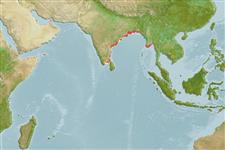Environment: milieu / climate zone / depth range / distribution range
Sinh thái học
Biển; Nước ngọt; Thuộc về nước lợ; sống cả ở nước ngọt và nuớc mặn (Ref. 51243); Mức độ sâu 0 - 50 m (Ref. 189). Tropical; 26°N - 7°N, 76°E - 99°E (Ref. 189)
Indian Ocean: eastern coasts and estuaries of India, and also Irrawaddy River at Rangoon, Myanmar. All Indian references to a species with over 7 pectoral filaments must apply to Coilia reynaldi.
Bộ gần gũi / Khối lượng (Trọng lượng) / Age
Maturity: Lm ? range ? - ? cm
Max length : 15.0 cm TL con đực/không giới tính; (Ref. 189)
Short description
Hình thái học | Sinh trắc học
Các tia vây lưng cứng (tổng cộng): 0; Tia cứng vây hậu môn 0; Tia mềm vây hậu môn: 80. Body tapering, belly rounded before pelvic fins, with 6 to 9 + 7 to 11 = 13 to 19 keeled scutes from just behind pectoral fin base to anus. Maxilla short, not reaching to edge of gill cover. Pectoral fin with 10 to 13 long filaments; the branched fin rays much shorter those of pelvic fin.
Occurs in coastal and tidal stretches of rivers, but apparently no data on salinity tolerances. Its presence above Barrackpore on the Hooghly in India suggests that it can live in freshwater. Larvae feed on copepods; thereafter mainly on copepods, but also on prawns, larval decapods and other crustaceans. Breeds in the lower parts of estuaries. The time and duration of the breeding season reported vary for different estuaries in India.
Breeds in lower parts of estuaries (Ref. 189). Spawn in school (Ref. 205).
Whitehead, P.J.P., G.J. Nelson and T. Wongratana, 1988. FAO Species Catalogue. Vol. 7. Clupeoid fishes of the world (Suborder Clupeoidei). An annotated and illustrated catalogue of the herrings, sardines, pilchards, sprats, shads, anchovies and wolf-herrings. FAO Fish. Synop. 125(7/2):305-579. Rome: FAO. (Ref. 189)
IUCN Red List Status (Ref. 130435)
Threat to humans
Harmless
Human uses
Các nghề cá: buôn bán nhỏ
Thêm thông tin
Các tài liệu tham khảoNuôi trồng thủy sảnTổng quan nuôi trồng thủy sảnCác giốngDi truyềnElectrophoresesDi sảnCác bệnhChế biếnNutrientsMass conversion
Các công cụ
Special reports
Download XML
Các nguồn internet
Estimates based on models
Preferred temperature (Ref.
123201): 27.9 - 28.9, mean 28.4 °C (based on 48 cells).
Phylogenetic diversity index (Ref.
82804): PD
50 = 0.5001 [Uniqueness, from 0.5 = low to 2.0 = high].
Bayesian length-weight: a=0.00282 (0.00124 - 0.00641), b=3.10 (2.92 - 3.28), in cm total length, based on LWR estimates for this Genus-body shape (Ref.
93245).
Mức dinh dưỡng (Ref.
69278): 3.3 ±0.46 se; based on food items.
Generation time: 1.6 ( na - na) years. Estimated as median ln(3)/K based on 1
growth studies.
Thích nghi nhanh (Ref.
120179): Chiêù cao, thời gian nhân đôi của chủng quần tối thiểu là dưới 15 tháng (K=0.7).
Fishing Vulnerability (Ref.
59153): Low vulnerability (20 of 100).
